To Live Your Life Exchanging of Products for Products Articles 2022
VerifiedAdded on 2022/08/25
|5
|1450
|21
AI Summary
Contribute Materials
Your contribution can guide someone’s learning journey. Share your
documents today.
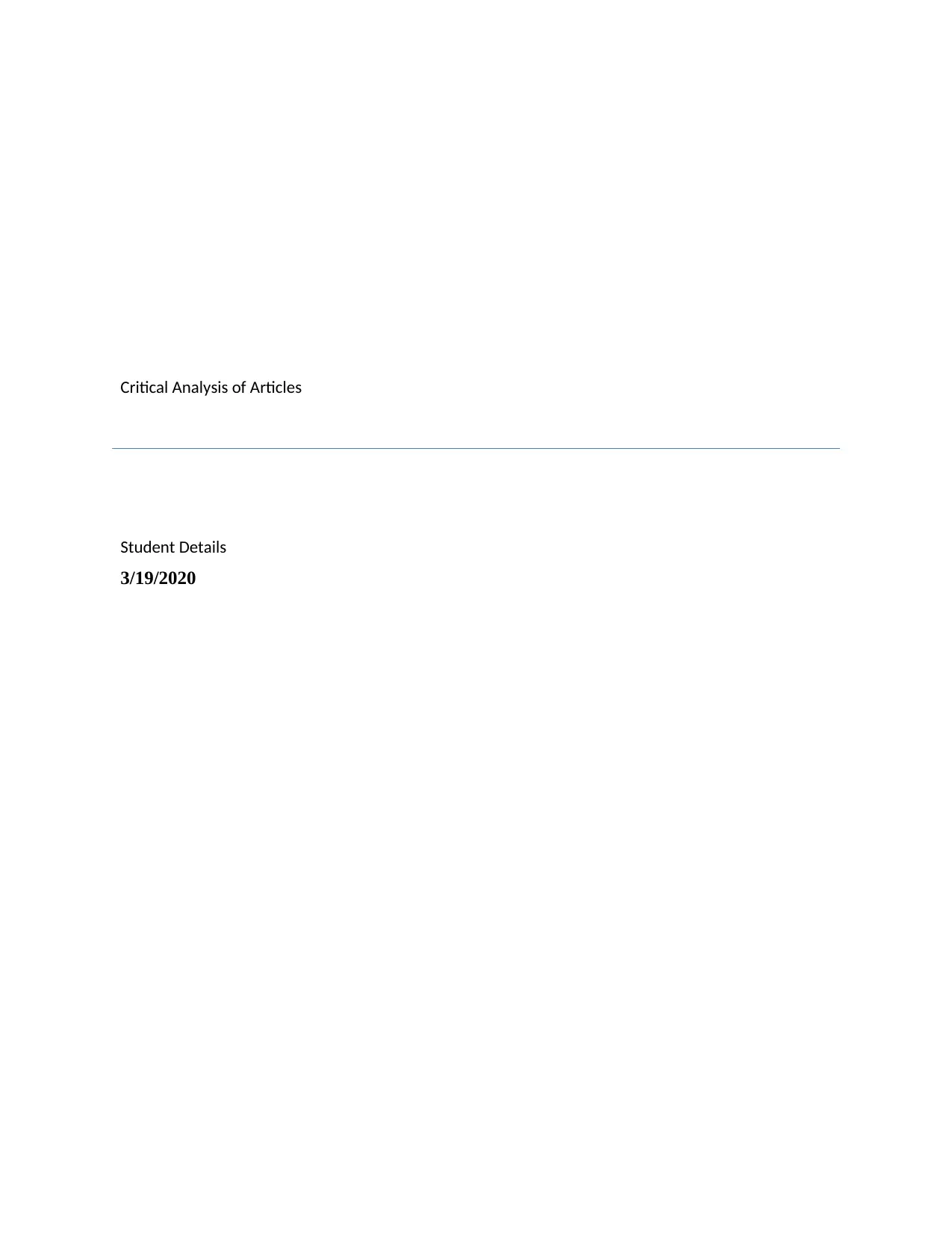
Critical Analysis of Articles
Student Details
3/19/2020
Student Details
3/19/2020
Secure Best Marks with AI Grader
Need help grading? Try our AI Grader for instant feedback on your assignments.
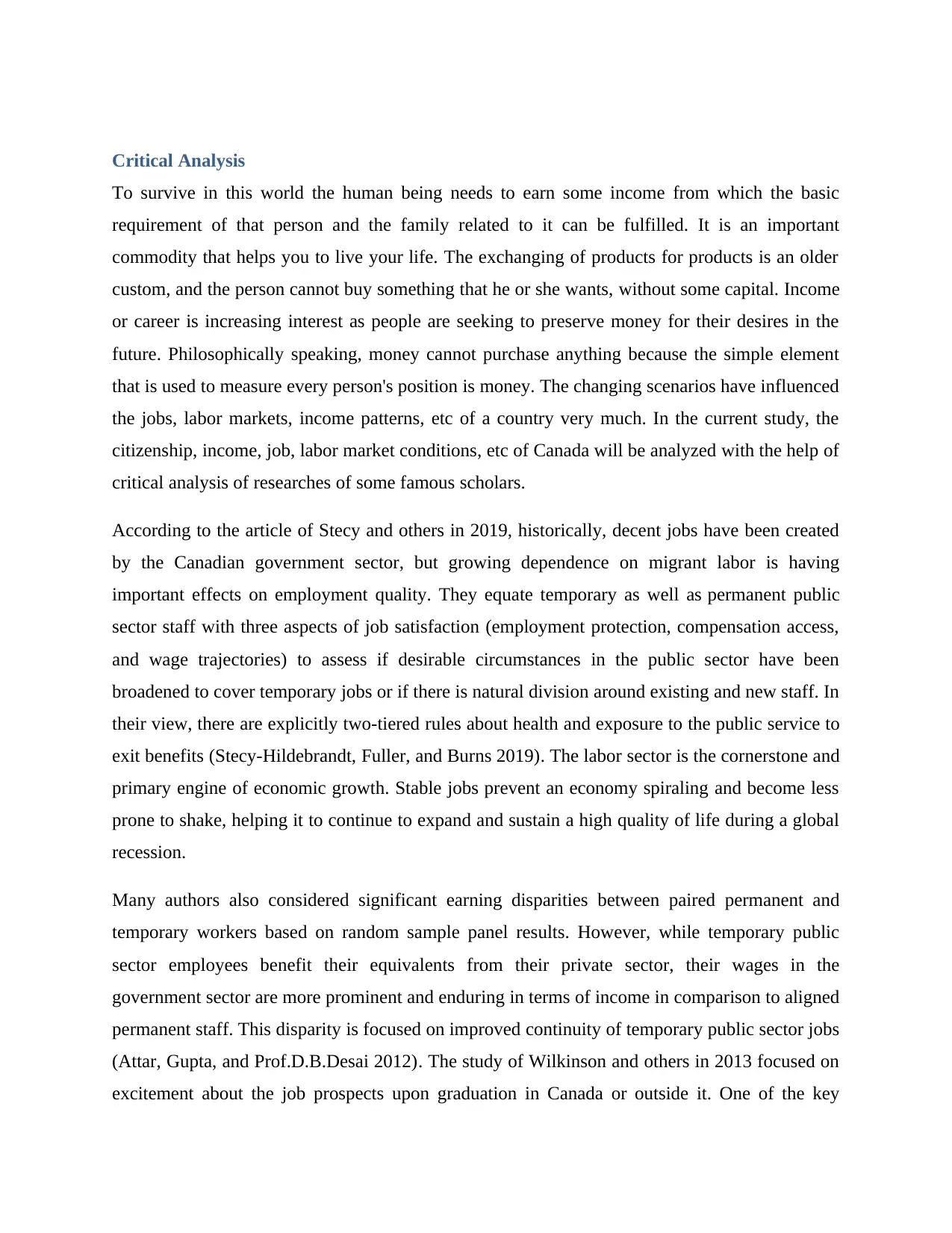
Critical Analysis
To survive in this world the human being needs to earn some income from which the basic
requirement of that person and the family related to it can be fulfilled. It is an important
commodity that helps you to live your life. The exchanging of products for products is an older
custom, and the person cannot buy something that he or she wants, without some capital. Income
or career is increasing interest as people are seeking to preserve money for their desires in the
future. Philosophically speaking, money cannot purchase anything because the simple element
that is used to measure every person's position is money. The changing scenarios have influenced
the jobs, labor markets, income patterns, etc of a country very much. In the current study, the
citizenship, income, job, labor market conditions, etc of Canada will be analyzed with the help of
critical analysis of researches of some famous scholars.
According to the article of Stecy and others in 2019, historically, decent jobs have been created
by the Canadian government sector, but growing dependence on migrant labor is having
important effects on employment quality. They equate temporary as well as permanent public
sector staff with three aspects of job satisfaction (employment protection, compensation access,
and wage trajectories) to assess if desirable circumstances in the public sector have been
broadened to cover temporary jobs or if there is natural division around existing and new staff. In
their view, there are explicitly two-tiered rules about health and exposure to the public service to
exit benefits (Stecy-Hildebrandt, Fuller, and Burns 2019). The labor sector is the cornerstone and
primary engine of economic growth. Stable jobs prevent an economy spiraling and become less
prone to shake, helping it to continue to expand and sustain a high quality of life during a global
recession.
Many authors also considered significant earning disparities between paired permanent and
temporary workers based on random sample panel results. However, while temporary public
sector employees benefit their equivalents from their private sector, their wages in the
government sector are more prominent and enduring in terms of income in comparison to aligned
permanent staff. This disparity is focused on improved continuity of temporary public sector jobs
(Attar, Gupta, and Prof.D.B.Desai 2012). The study of Wilkinson and others in 2013 focused on
excitement about the job prospects upon graduation in Canada or outside it. One of the key
To survive in this world the human being needs to earn some income from which the basic
requirement of that person and the family related to it can be fulfilled. It is an important
commodity that helps you to live your life. The exchanging of products for products is an older
custom, and the person cannot buy something that he or she wants, without some capital. Income
or career is increasing interest as people are seeking to preserve money for their desires in the
future. Philosophically speaking, money cannot purchase anything because the simple element
that is used to measure every person's position is money. The changing scenarios have influenced
the jobs, labor markets, income patterns, etc of a country very much. In the current study, the
citizenship, income, job, labor market conditions, etc of Canada will be analyzed with the help of
critical analysis of researches of some famous scholars.
According to the article of Stecy and others in 2019, historically, decent jobs have been created
by the Canadian government sector, but growing dependence on migrant labor is having
important effects on employment quality. They equate temporary as well as permanent public
sector staff with three aspects of job satisfaction (employment protection, compensation access,
and wage trajectories) to assess if desirable circumstances in the public sector have been
broadened to cover temporary jobs or if there is natural division around existing and new staff. In
their view, there are explicitly two-tiered rules about health and exposure to the public service to
exit benefits (Stecy-Hildebrandt, Fuller, and Burns 2019). The labor sector is the cornerstone and
primary engine of economic growth. Stable jobs prevent an economy spiraling and become less
prone to shake, helping it to continue to expand and sustain a high quality of life during a global
recession.
Many authors also considered significant earning disparities between paired permanent and
temporary workers based on random sample panel results. However, while temporary public
sector employees benefit their equivalents from their private sector, their wages in the
government sector are more prominent and enduring in terms of income in comparison to aligned
permanent staff. This disparity is focused on improved continuity of temporary public sector jobs
(Attar, Gupta, and Prof.D.B.Desai 2012). The study of Wilkinson and others in 2013 focused on
excitement about the job prospects upon graduation in Canada or outside it. One of the key
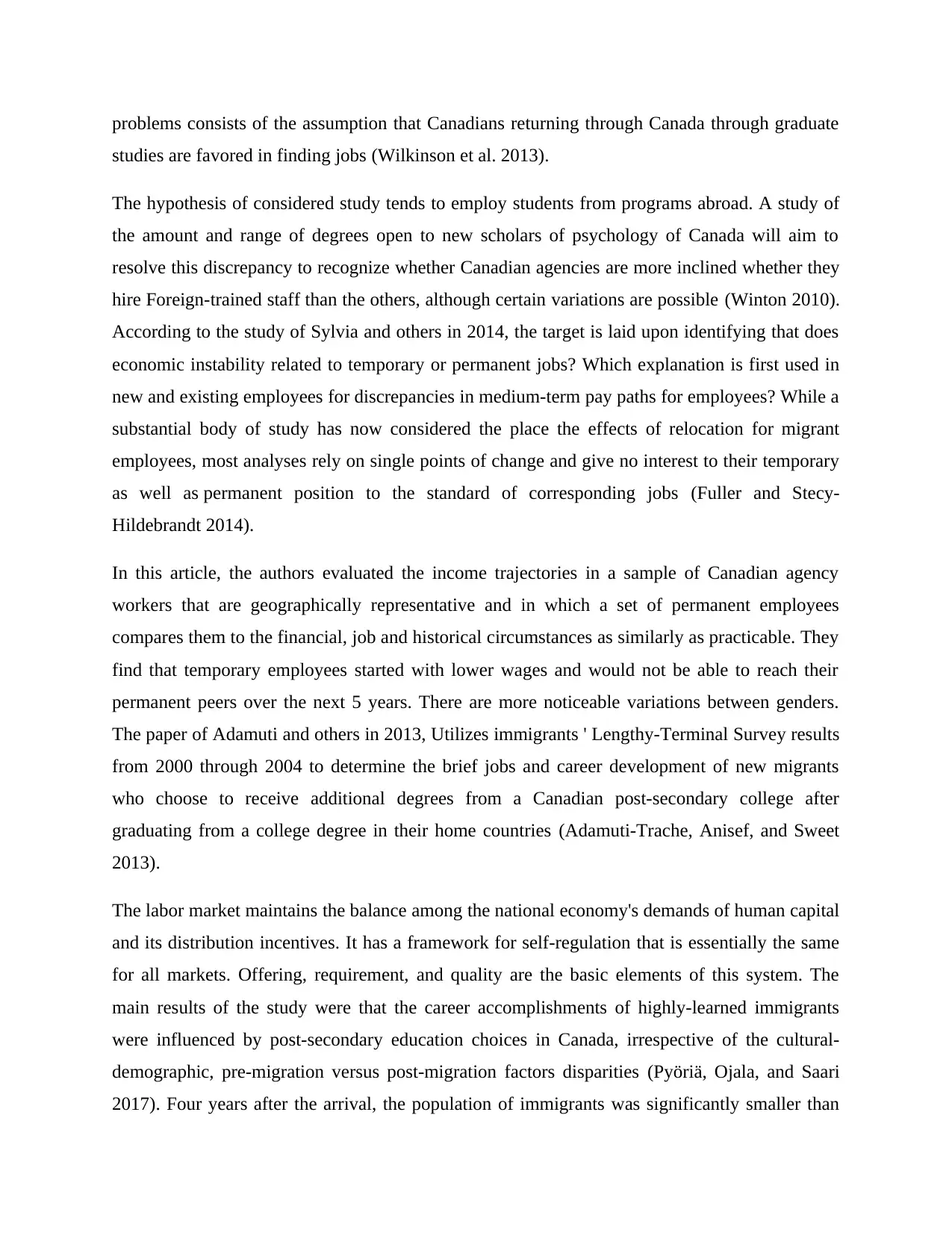
problems consists of the assumption that Canadians returning through Canada through graduate
studies are favored in finding jobs (Wilkinson et al. 2013).
The hypothesis of considered study tends to employ students from programs abroad. A study of
the amount and range of degrees open to new scholars of psychology of Canada will aim to
resolve this discrepancy to recognize whether Canadian agencies are more inclined whether they
hire Foreign-trained staff than the others, although certain variations are possible (Winton 2010).
According to the study of Sylvia and others in 2014, the target is laid upon identifying that does
economic instability related to temporary or permanent jobs? Which explanation is first used in
new and existing employees for discrepancies in medium-term pay paths for employees? While a
substantial body of study has now considered the place the effects of relocation for migrant
employees, most analyses rely on single points of change and give no interest to their temporary
as well as permanent position to the standard of corresponding jobs (Fuller and Stecy‐
Hildebrandt 2014).
In this article, the authors evaluated the income trajectories in a sample of Canadian agency
workers that are geographically representative and in which a set of permanent employees
compares them to the financial, job and historical circumstances as similarly as practicable. They
find that temporary employees started with lower wages and would not be able to reach their
permanent peers over the next 5 years. There are more noticeable variations between genders.
The paper of Adamuti and others in 2013, Utilizes immigrants ' Lengthy-Terminal Survey results
from 2000 through 2004 to determine the brief jobs and career development of new migrants
who choose to receive additional degrees from a Canadian post-secondary college after
graduating from a college degree in their home countries (Adamuti‐Trache, Anisef, and Sweet
2013).
The labor market maintains the balance among the national economy's demands of human capital
and its distribution incentives. It has a framework for self-regulation that is essentially the same
for all markets. Offering, requirement, and quality are the basic elements of this system. The
main results of the study were that the career accomplishments of highly-learned immigrants
were influenced by post-secondary education choices in Canada, irrespective of the cultural-
demographic, pre-migration versus post-migration factors disparities (Pyöriä, Ojala, and Saari
2017). Four years after the arrival, the population of immigrants was significantly smaller than
studies are favored in finding jobs (Wilkinson et al. 2013).
The hypothesis of considered study tends to employ students from programs abroad. A study of
the amount and range of degrees open to new scholars of psychology of Canada will aim to
resolve this discrepancy to recognize whether Canadian agencies are more inclined whether they
hire Foreign-trained staff than the others, although certain variations are possible (Winton 2010).
According to the study of Sylvia and others in 2014, the target is laid upon identifying that does
economic instability related to temporary or permanent jobs? Which explanation is first used in
new and existing employees for discrepancies in medium-term pay paths for employees? While a
substantial body of study has now considered the place the effects of relocation for migrant
employees, most analyses rely on single points of change and give no interest to their temporary
as well as permanent position to the standard of corresponding jobs (Fuller and Stecy‐
Hildebrandt 2014).
In this article, the authors evaluated the income trajectories in a sample of Canadian agency
workers that are geographically representative and in which a set of permanent employees
compares them to the financial, job and historical circumstances as similarly as practicable. They
find that temporary employees started with lower wages and would not be able to reach their
permanent peers over the next 5 years. There are more noticeable variations between genders.
The paper of Adamuti and others in 2013, Utilizes immigrants ' Lengthy-Terminal Survey results
from 2000 through 2004 to determine the brief jobs and career development of new migrants
who choose to receive additional degrees from a Canadian post-secondary college after
graduating from a college degree in their home countries (Adamuti‐Trache, Anisef, and Sweet
2013).
The labor market maintains the balance among the national economy's demands of human capital
and its distribution incentives. It has a framework for self-regulation that is essentially the same
for all markets. Offering, requirement, and quality are the basic elements of this system. The
main results of the study were that the career accomplishments of highly-learned immigrants
were influenced by post-secondary education choices in Canada, irrespective of the cultural-
demographic, pre-migration versus post-migration factors disparities (Pyöriä, Ojala, and Saari
2017). Four years after the arrival, the population of immigrants was significantly smaller than
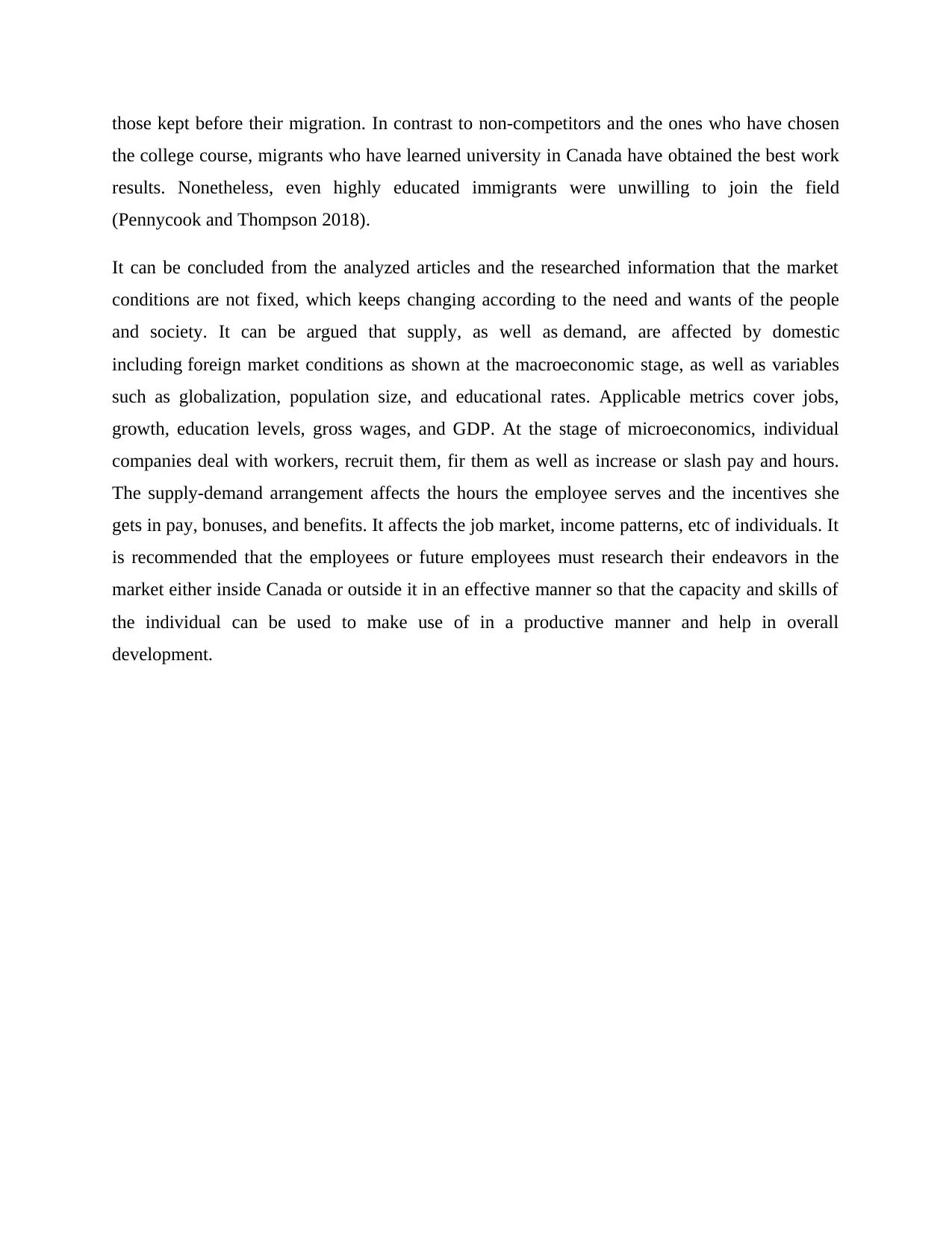
those kept before their migration. In contrast to non-competitors and the ones who have chosen
the college course, migrants who have learned university in Canada have obtained the best work
results. Nonetheless, even highly educated immigrants were unwilling to join the field
(Pennycook and Thompson 2018).
It can be concluded from the analyzed articles and the researched information that the market
conditions are not fixed, which keeps changing according to the need and wants of the people
and society. It can be argued that supply, as well as demand, are affected by domestic
including foreign market conditions as shown at the macroeconomic stage, as well as variables
such as globalization, population size, and educational rates. Applicable metrics cover jobs,
growth, education levels, gross wages, and GDP. At the stage of microeconomics, individual
companies deal with workers, recruit them, fir them as well as increase or slash pay and hours.
The supply-demand arrangement affects the hours the employee serves and the incentives she
gets in pay, bonuses, and benefits. It affects the job market, income patterns, etc of individuals. It
is recommended that the employees or future employees must research their endeavors in the
market either inside Canada or outside it in an effective manner so that the capacity and skills of
the individual can be used to make use of in a productive manner and help in overall
development.
the college course, migrants who have learned university in Canada have obtained the best work
results. Nonetheless, even highly educated immigrants were unwilling to join the field
(Pennycook and Thompson 2018).
It can be concluded from the analyzed articles and the researched information that the market
conditions are not fixed, which keeps changing according to the need and wants of the people
and society. It can be argued that supply, as well as demand, are affected by domestic
including foreign market conditions as shown at the macroeconomic stage, as well as variables
such as globalization, population size, and educational rates. Applicable metrics cover jobs,
growth, education levels, gross wages, and GDP. At the stage of microeconomics, individual
companies deal with workers, recruit them, fir them as well as increase or slash pay and hours.
The supply-demand arrangement affects the hours the employee serves and the incentives she
gets in pay, bonuses, and benefits. It affects the job market, income patterns, etc of individuals. It
is recommended that the employees or future employees must research their endeavors in the
market either inside Canada or outside it in an effective manner so that the capacity and skills of
the individual can be used to make use of in a productive manner and help in overall
development.
Secure Best Marks with AI Grader
Need help grading? Try our AI Grader for instant feedback on your assignments.
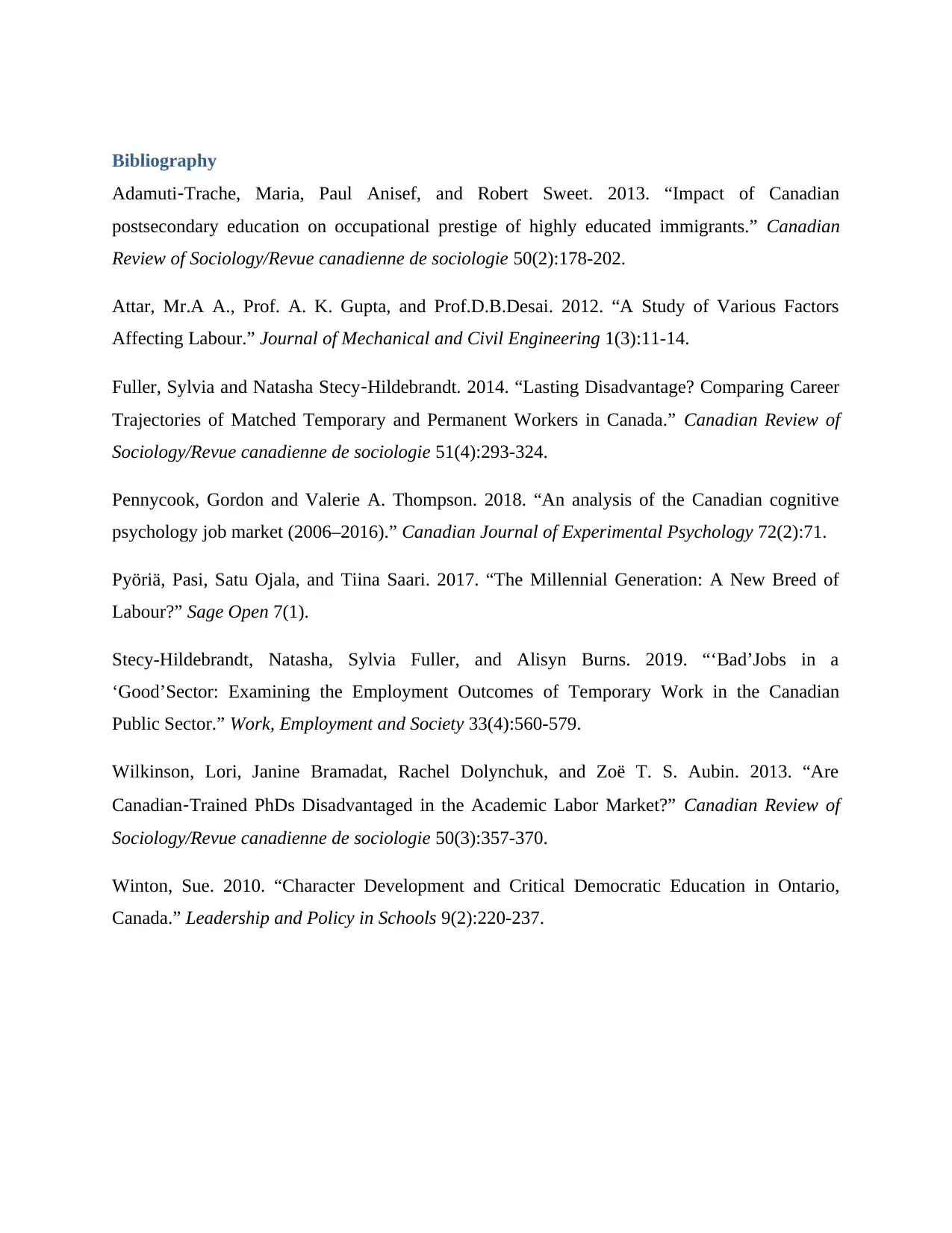
Bibliography
Adamuti‐Trache, Maria, Paul Anisef, and Robert Sweet. 2013. “Impact of Canadian
postsecondary education on occupational prestige of highly educated immigrants.” Canadian
Review of Sociology/Revue canadienne de sociologie 50(2):178-202.
Attar, Mr.A A., Prof. A. K. Gupta, and Prof.D.B.Desai. 2012. “A Study of Various Factors
Affecting Labour.” Journal of Mechanical and Civil Engineering 1(3):11-14.
Fuller, Sylvia and Natasha Stecy‐Hildebrandt. 2014. “Lasting Disadvantage? Comparing Career
Trajectories of Matched Temporary and Permanent Workers in Canada.” Canadian Review of
Sociology/Revue canadienne de sociologie 51(4):293-324.
Pennycook, Gordon and Valerie A. Thompson. 2018. “An analysis of the Canadian cognitive
psychology job market (2006–2016).” Canadian Journal of Experimental Psychology 72(2):71.
Pyöriä, Pasi, Satu Ojala, and Tiina Saari. 2017. “The Millennial Generation: A New Breed of
Labour?” Sage Open 7(1).
Stecy-Hildebrandt, Natasha, Sylvia Fuller, and Alisyn Burns. 2019. “‘Bad’Jobs in a
‘Good’Sector: Examining the Employment Outcomes of Temporary Work in the Canadian
Public Sector.” Work, Employment and Society 33(4):560-579.
Wilkinson, Lori, Janine Bramadat, Rachel Dolynchuk, and Zoë T. S. Aubin. 2013. “Are
Canadian‐Trained PhDs Disadvantaged in the Academic Labor Market?” Canadian Review of
Sociology/Revue canadienne de sociologie 50(3):357-370.
Winton, Sue. 2010. “Character Development and Critical Democratic Education in Ontario,
Canada.” Leadership and Policy in Schools 9(2):220-237.
Adamuti‐Trache, Maria, Paul Anisef, and Robert Sweet. 2013. “Impact of Canadian
postsecondary education on occupational prestige of highly educated immigrants.” Canadian
Review of Sociology/Revue canadienne de sociologie 50(2):178-202.
Attar, Mr.A A., Prof. A. K. Gupta, and Prof.D.B.Desai. 2012. “A Study of Various Factors
Affecting Labour.” Journal of Mechanical and Civil Engineering 1(3):11-14.
Fuller, Sylvia and Natasha Stecy‐Hildebrandt. 2014. “Lasting Disadvantage? Comparing Career
Trajectories of Matched Temporary and Permanent Workers in Canada.” Canadian Review of
Sociology/Revue canadienne de sociologie 51(4):293-324.
Pennycook, Gordon and Valerie A. Thompson. 2018. “An analysis of the Canadian cognitive
psychology job market (2006–2016).” Canadian Journal of Experimental Psychology 72(2):71.
Pyöriä, Pasi, Satu Ojala, and Tiina Saari. 2017. “The Millennial Generation: A New Breed of
Labour?” Sage Open 7(1).
Stecy-Hildebrandt, Natasha, Sylvia Fuller, and Alisyn Burns. 2019. “‘Bad’Jobs in a
‘Good’Sector: Examining the Employment Outcomes of Temporary Work in the Canadian
Public Sector.” Work, Employment and Society 33(4):560-579.
Wilkinson, Lori, Janine Bramadat, Rachel Dolynchuk, and Zoë T. S. Aubin. 2013. “Are
Canadian‐Trained PhDs Disadvantaged in the Academic Labor Market?” Canadian Review of
Sociology/Revue canadienne de sociologie 50(3):357-370.
Winton, Sue. 2010. “Character Development and Critical Democratic Education in Ontario,
Canada.” Leadership and Policy in Schools 9(2):220-237.
1 out of 5
Your All-in-One AI-Powered Toolkit for Academic Success.
+13062052269
info@desklib.com
Available 24*7 on WhatsApp / Email
![[object Object]](/_next/static/media/star-bottom.7253800d.svg)
Unlock your academic potential
© 2024 | Zucol Services PVT LTD | All rights reserved.